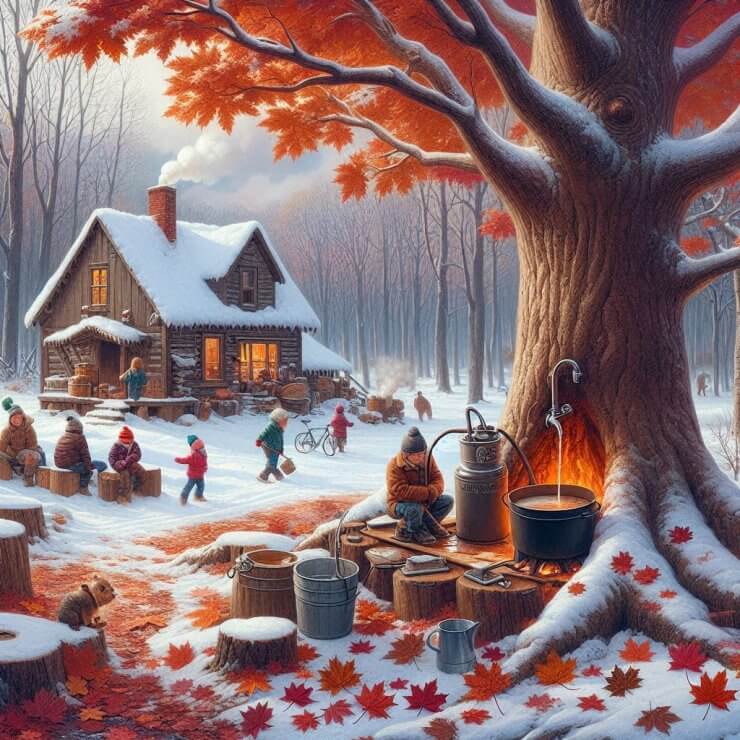Read by Michael Flamel

I’ve been a lifelong fan of maple trees, perhaps even before I understood where my beloved maple syrup originated. As a kid, maple syrup was the magic elixir that turned pancakes into something worth leaping out of bed. And yes, I’m the kind of guy who goes out for breakfast and asks the waitress for the real maple syrup—agreeing to pay an extra dollar or two for the privilege. There’s just something about that rich, amber sweetness that no other syrup can match.
As I grew older and wiser in the ways of the world (and breakfast foods), I started looking for ways to incorporate maple syrup into more than just pancakes and waffles. If you’re like me, always on the lookout for ways to substitute maple syrup for other, less New England-y sweeteners, then you know it’s the secret ingredient that makes everything from baked beans to vinaigrettes a little better.
But enough about syrup (for now)—let’s talk about the source: the marvelous maple tree.
The Origins of Maple Trees
Maple trees have been gracing the earth for millions of years, long before anyone thought to drill a hole in one and see what came out. The sugar maple (Acer saccharum) is the star of the show when it comes to syrup production, but it’s just one member of a family that includes more than 100 species. Maples are native to the cooler climates of the Northern Hemisphere, with the highest diversity in China. In North America, they’ve spread across the continent, thriving in the temperate regions of the United States and Canada.
Maples were cherished by Indigenous peoples long before European settlers arrived. The process of tapping trees and boiling down the sap to make syrup is believed to have been discovered by Native Americans, who passed the knowledge on to early colonists. This practice has remained largely unchanged for centuries, a testament to the tree’s enduring appeal.
Planting Your Own Maple Tree
If you’ve ever dreamed of having your own maple tree—perhaps even one that could supply you with homemade syrup—there are a few things to keep in mind. First, choose the right species for your climate. Sugar maples are the go-to for syrup, but if you live in a warmer region, consider the red maple (Acer rubrum) or the silver maple (Acer saccharinum), both of which are more heat-tolerant.
Maples thrive in well-drained soil and prefer full sun, though they can tolerate partial shade. When planting, give your tree plenty of space to grow—maples can reach heights of 40 to 100 feet, with equally impressive spreads. Once established, these trees are relatively low-maintenance, offering beautiful foliage in the fall and, of course, the potential for syrup production if you’re up for a bit of DIY adventure.
Fun Maple Tree Facts
Leaf Lovers: The maple leaf is such an icon that it’s the national symbol of Canada.
Tree Tappers: It takes about 40 gallons of sap to produce just one gallon of maple syrup.
Sweet Sap: The sap of the sugar maple contains about 2% sugar, which is why it’s the preferred species for syrup production.
The Magic of Maple Syrup Production
Tapping a maple tree is as simple as drilling a hole into the trunk and inserting a spout to collect the sap as it flows out. But the real magic happens when that sap is boiled down into syrup. This reduction process can take hours, and if you’re doing it the traditional way—over a wood fire in the great outdoors—you’re in for a treat. I’ve had the privilege of attending such a syrup-making party in the heart of a New England Winter, and it’s an experience I’d recommend to anyone. There’s nothing quite like the smell of wood smoke and boiling sap, the camaraderie of friends gathered around the fire, and the sweet reward at the end.
Once you’ve got your syrup, the possibilities are endless. Of course, you’ll want to drizzle it over your pancakes, but why stop there? Maple syrup can add a delightful depth of flavor to roasted vegetables, marinades, glazes for meats, and even cocktails. And let’s not forget about baking—maple syrup can be a wonderful substitute for sugar in cakes, cookies, and breads.
Types of Maple Syrup
Golden: Light and mild, perfect for those who prefer a subtle sweetness.
Amber: Rich and full-bodied, the most popular choice for everyday use.
Dark: Bold and robust, ideal for cooking and adding a strong maple flavor.
Very Dark: Intense and complex, often used for commercial purposes or by those who love a deep, dark syrup.
So, if you’re looking to add a bit of New England charm to your life, consider planting a maple tree—or at least keeping a bottle of real maple syrup on hand. Trust me, your pancakes will thank you. ❖


 Previous
Previous

